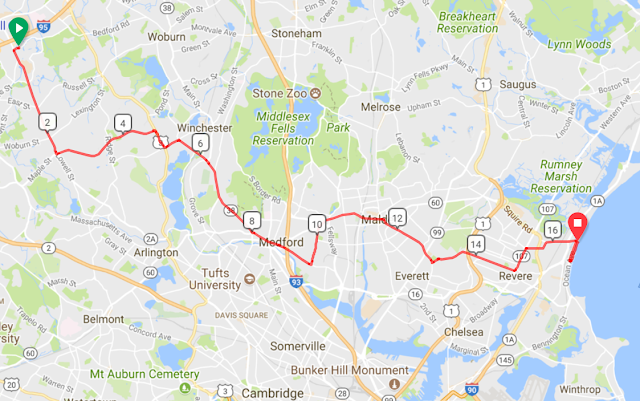Day 6 - Thursday, May 17th - Wickenburg to Prescott, AZ
Distance: 59.8 miles
Elevation Gain: +6077 ft. or 101.6 ft./mile
This is the first of three climbing days that total nearly 14,000 feet of elevation gain, 13% of the tour total. From the outset nearly every rider in the tour has had these three days circled.
A short mileage day, but nearly 6100 feet of elevation gain, the biggest day of elevation gain on the tour and one of two days with a net
elevation change of over 3000 feet. The tour itinerary tells us this is our first mountain pass
in Yarnell at 4850 feet right around mile 25. We basically start climbing
right out of the hotel parking lot. Most of the pics that follow are from the bike while riding so this helps explain some of the poor composition. Pics from the actual climb are few and far between. Once I got going I really didn't want to stop unless I had to, or the view just had to be appreciated.
Traffic rotary in Wickenburg
The road out of Wickenburg
The first 17 miles are relatively flat with a net
elevation change of about 1,000 feet where we pass through Congress at mile 16 and turn northeast.
Congress was initially a gold mining town when gold was discovered in 1884 and prospered until the mine closed in the mid 1930’s. Today it is a retirement and bedroom community for Wickenburg.
The first climb begins at mile 17, goes for 7.3 miles and roughly 2000 feet of elevation gain
on the way to our only SAG stop of the day, Yarnell Pass. This morning we were told about "false flats". In a nutshell the road looks flat or slightly descending. Turns out it is an optical illusion and you are actually climbing. Here is a picture of the phenomena.
I know you don't believe me, but we were climbing. Weird.
We pass just south of the trailhead for Granite Mountain Hotshot Memorial State Park at mile 22. The park was created in 2016 to honor the 19 Granite Mountain Hotshot firefighters who died on June 30, 2013 while working the Yarnell Hill fire, the deadliest wildfire in Arizona history. The fire started on June 28, ignited by lightning, and on June 30th strong winds in excess of 20 mph pushed the area of the fire from about 300 acres to over 2000 acres. By July 1 the fire had spread to over 8300 acres despite efforts of more than 400 firefighters, prompting evacuations. It took another 10 days for the fire to be declared contained.
Finally at mile 25 we reach the summit and Yarnell. Yarnell has a population of about
650 and like so many other outposts in this part of Arizona, got its’ start
because of the discovery of gold around 1865 by a well-known local pioneer,
Charles Genung (and he didn’t even get the town named after him). A billboard
at the entrance to Yarnell declares that Yarnell is where the desert breeze
meets the mountain air. The economy today is based on ranching, mining and
services to retirees and travelers. Some pics from the road up and the summit
Leaving Yarnell we mostly descend for the next twelve miles passing
a number of cattle ranches starting at mile 29 before getting to Kirkland Junction at mile 37.
And best of all....we had a tailwind. Look at that flag!!
The next climb begins in Kirkland at mile 37 and is about 10 miles long makes up the most of the balance of the remaining 3000 feet of elevation gain as we get to the high point for the day at 6100 feet before descending into Prescott. Some pics form this second summit
Part of the road we came up
Sneak Peak at Tomorrow
In terms of elevation gain, the 44 mile ride to Cottonwood is the easiest of this three day stretch with just over 2800 feet of gain. The challenge looks to be that about 2000 of that happens in a 12 mile stretch as we climb Mingus Mountain on the way to Jerome to an elevation of just over 7,000 feet. Compared to our other descents, this one looks challenging as well with tight switchbacks and rough road.
Cottonwood with a population of 12,000, is located
at an elevation of 3300 feet and is named for the Cottonwood tree. The first
settlers farmed and provided goods for soldiers in Camp Verde and miners in
Jerome starting in the 1870s. Nearly all the towns in the area were company
towns controlled by the mining companies. Old Town Cottonwood became a haven
for those wanting to steer clear of that type of living.























Comments
Post a Comment